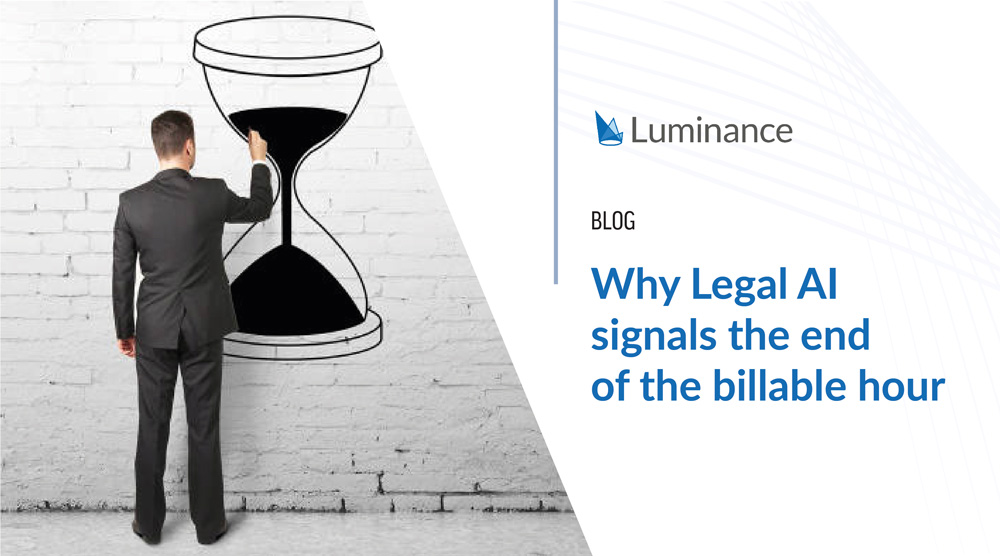
Blog
Why Legal AI signals the end of the ‘billable hour’
13 December 2019 | Luminance
The billable hour has long been at the bedrock of traditional law firms, representing a direct link between legal services (input) and revenue (output). But this outdated way of valuing legal services is wholly incompatible with the current market and customer demands. With the new dawn of Legal AI, law firms no longer have to adopt a framework which unnecessarily constricts the way lawyers work and threatens an industry with legal burnout.
The billable hour in practice
The billable hour was first developed as a means of increasing profit for law firms, as well as a way of keeping track of clients’ fees and monitoring annual billing targets. Since then, the legal industry has changed quite radically, and so have clients’ expectations.
At the heart of this, is that the value of legal services is no longer measured by the time it takes to review a case. Instead it is about instilling confidence in clients that they are receiving the best possible advice from their trusted advisor. In other words, it is about the real and practical results of legal services.
The death of the billable hour
A target-based approach constrains lawyers in the way that they approach legal issues. Efficiency, productivity, skills development and client collaboration are all factors which are crucial in the delivery of effective legal advice, but are all penalised under a time selling framework.
Moreover, the toll the billable hour is having on the mental health of lawyers is not something that we can take lightly. LawCare recently found that the billable hour system has contributed to lawyers feeling unmotivated, unsatisfied as well as displaying signs of mental distress. As a result, LawCare reported that a more nuanced, outcome-based framework which embraces the individual autonomy of legal advisors can lead to greater job satisfaction, greater motivation, as well as decreasing employee turnover.
The call for the end of billable hour is nowhere louder than from our junior lawyers. The Lawyer’s student publication, Laywer 2B, found that for 17% of trainee lawyers, billing targets are the biggest cause of stress. In order to retain our best and brightest talent, law firms need to keep the pace of change and abolish an inefficient and outmoded framework.
It is therefore not unsurprising that Magic Circle law firms such as Slaughter and May have made the move away from time targets and billing, citing the desire to achieve better results and better working conditions for their advisors. The US-based firm Watchell, Lipton, Rosen & Katz are also renowned for a business model which charges client based on ‘…the intensity of the firm’s efforts, the responsibility assumed, the complexity of the matter and the results achieved’.
An outcome-based pricing model is something Emily Foges, CEO of Luminance, has discussed in detail: “Value-based pricing underpins a healthy industry. That way, when technology matures and cycle times are slashed, profitability increases.”
Revolutionary Legal AI
Legal AI is revolutionising the way advisors are conducting document review and raising serious questions about the billable hour system. By capitalising on ground-breaking machine learning, Luminance provides advisors with an immediate and unparalleled insight into legal datasets. This is all due to Luminance’s core technology, ‘LITE’ (Legal Inference Transformation Engine), supercharging lawyers so that less time is spent on repetitive, tedious tasks and focus can be directed to getting to the crux of the deal promptly and effectively. In fact, our clients report on experiencing at least 50% time-savings when compared to manual review, rising to over 1000% time-savings in many cases.
By immediately reading and understanding huge volumes of complex legal data, Luminance’s technology cuts out the grunt work and empowers lawyers to deliver legal services which truly encapsulate the analysis, expertise and experience they have spent years honing. This is then displayed on an intuitive and easy-to-use interface, enabling lawyers to identify the areas of risk or importance in any given body of documents. As a result, measuring the ‘time’ in which legal work is completed is redundant.
Legal AI brings new possibilities for the legal profession. It is now law firms’ responsibility to ensure that they develop and modernise to get the most out of lawyers and meet the demands of their clients and key to this is the abolition of the billable hour. Using Luminance, this might just be possible.